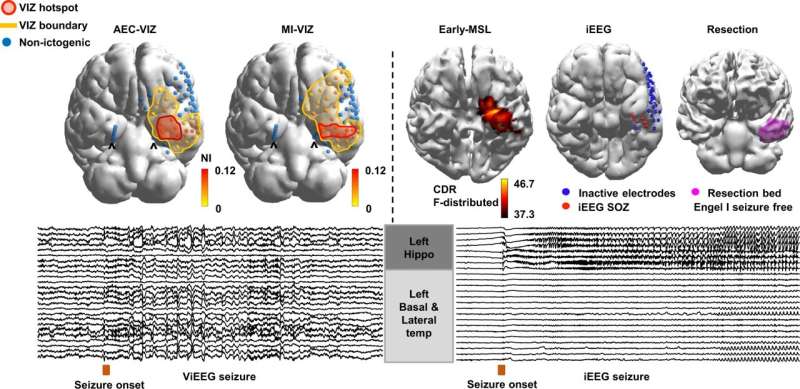(Patient 5) Morphological and spatial characteristics of ictal ViEEG signals and concordance between VIZ, iEEG SOZ, and early-MSL. While carrying a slightly different morphology to the corresponding iEEG ictal rhythm, distinct ictal waveforms are seen in the left anterior hippocampal structure and left basal temporal region from a ViEEG seizure aligned in time with seizure onset identified by MEG sensor signals. This is spatially concordant with a seizure captured by iEEG after the MEG recording, where the seizure starts from the left anterior hippocampus and spreads to the left basal temporal area. AEC-VIZ and MI-VIZ identified by dynamical network models are similar with boundaries containing the iEEG SOZ, resection margin and early-MSL (earliest ictal source localisation solution accounting for 90% of the signal variance from averaged discharge take-off towards the peak)31. Both AEC-VIZ and MI-VIZ hotspots (high NI values) point to the left anterior hippocampus, entorhinal cortex and basal temporal structures. The patient has been seizure-free for over 2 years post-surgery and histology showed cortical dysplasia at the entorhinal cortex. Both AEC-VIZ and MI-VIZ appear to have captured the likely EZ (ViEEG hippocampal depth electrodes are denoted by hat symbols to distinguish them from the left lateral temporal ViEEG grid electrodes). Abbreviations: MEG magnetoencephalography, iEEG intracranial electroencephalography, ViEEG virtual intracranial electroencephalography, EZ epileptogenic zone, SOZ seizure onset zone, HDEEG high density electroencephalography, VIZ virtual ictogenic zone, MSL MEG source localisation, ESL HDEEG source localisation, AEC amplitude envelope correlation, MI mutual information, AEC-VIZ virtual ictogenic zone using amplitude envelope correlation, MI-VIZ virtual ictogenic zone using mutual information, NI node ictogenicity. Credit: DOI: 10.1038/s41467-022-28640-x
A team from the University of Melbourne in Australia and the University of Birmingham demonstrated that magnetoencephalographic (MEG) imaging can be used to produce a dynamic map of the whole brain during a seizure. Their results are published in Nature Communications.
Over 65 million people around the world have epilepsy. About one-third of those have seizures which are resistant to medication. In these cases brain surgery can be an effective treatment, but it is under-used because of the challenges of accurately identifying the specific brain networks involved in seizures in order to appropriately plan surgery.
Successful epilepsy surgery relies on being able to understand and monitor the neural processes in the brain that cause seizures. Currently, this is most commonly done by implanting electrodes on the surface of the brain. The technique is invasive and expensive, and it has limitations because it enables only a small number of networks to be monitored.
In a proof-of-concept study, the researchers worked with 12 people with epilepsy to reveal the sources of their seizures using MEG imaging. From these data a computer model of the brain was constructed, which enable virtual surgeries to be performed. The computer model provides a "real time" picture of brain areas involved in generating seizures. The researchers call their method virtual intracranial EEG (ViEEG).
The team was able to show that, using their technique, they could identify distinct characteristics such as hyper-synchronized rhythms, clear transitions from background "normal" activity, to the seizure state, and patterns caused by the seizure spreading through the brain. Although more research is required, the researchers believe the method can be used to pinpoint the precise area of the brain responsible for triggering seizures, which would be a surgical target.
Dr. Daniel Galvis, from the Centre for Systems Modelling and Quantitative Biomedicine, explained: "Planning surgery for epilepsy is complex—often requiring highly invasive procedures even prior to determining whether surgery is a viable option. Discovering new and non-invasive methods for characterizing the brain areas involved in seizure propagation opens up a promising pathway for improving surgical approaches and ensuring that patients benefit from life-changing surgery.
More information: Miao Cao et al, Virtual intracranial EEG signals reconstructed from MEG with potential for epilepsy surgery, Nature Communications (2022). DOI: 10.1038/s41467-022-28640-x
Journal information: Nature Communications
Provided by University of Birmingham























